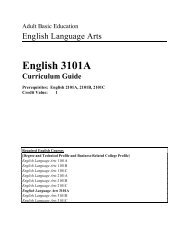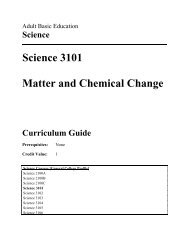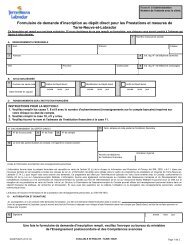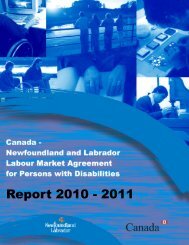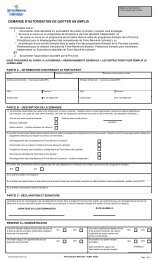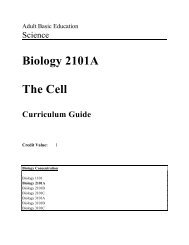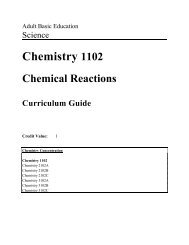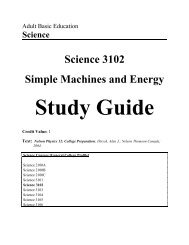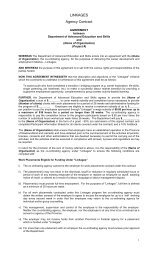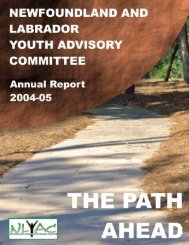World Literature 3101B Curriculum Guide 2012 Edition
World Literature 3101B Curriculum Guide 2012 Edition
World Literature 3101B Curriculum Guide 2012 Edition
You also want an ePaper? Increase the reach of your titles
YUMPU automatically turns print PDFs into web optimized ePapers that Google loves.
ResourcesThe recommended student and teacher resources for this course are given below.Instructors may, and are encouraged, to supplement these resources as they deemappropriate.Course<strong>World</strong> <strong>Literature</strong> <strong>3101B</strong>Resources<strong>World</strong> Mythology: An Anthology of theGreat Myths and Epics (8 th <strong>Edition</strong>). 2006.McGraw-Hill Glencoe. ISBN 0-07-872909-2 (9-780078729096).Teacher Manual. <strong>World</strong> Mythology: AnAnthology of the Great Myths and Epics(8 th <strong>Edition</strong>). 2006. McGraw-Hill Glencoe.ISBN 0-07-872910-6 (9-780078729102).The Crucible, by Arthur Miller.1952.Penguin Group. ISBN 978-0-14-048138-9(9-7801404-481389).One Selected NovelThe student resource selected for this course, <strong>World</strong> Mythology, is also on the list ofrecommended resources for <strong>World</strong> <strong>Literature</strong> 3207. This resource is an anthology of thegreat myths and epics from around the world. By studying the readings from variouscivilizations in this resource, ABE students will gain an appreciation for the stories,customs and folkways of the world’s peoples.This resource contains more than fifty myths and epics from the Middle East, Greece,Rome, the Far East and Pacific Islands, the British Isles, Northern Europe, Africa and theAmericas. Students will find an introduction and historical background to set the stage foreach selection, and place the selection in its cultural context. Questions are given at theend of each selection to enhance cultural thinking as they prompt students to analyze thestories, find similarities and differences, make assumptions, and examine their ownresponses.The recommended novels for this course are the same as for <strong>World</strong> <strong>Literature</strong> 3207.Students must select a novel from the list provided in the Study <strong>Guide</strong> and do not havethe choice to substitute other novels.Instructors are encouraged to become familiar with the Teacher Manual accompanyingthe student text. This Teacher Manual is designed to facilitate the use of the student text.5
Unit 2: Novel Study # 2 —Suggestions for Teaching, Learning and AssessmentSuggestions for Teaching and LearningSuggestions for Assessment9. There are eight recommended novels forthis course:• Flowers for Algernon, by DanielKeyes (1959). Information on thisAmerican novel is easily foundonline.• Ella Minnow Pea, by Mark Dunn(2001). Information on thisAmerican novel is easily foundonline.• The Alchemist, by Paulo Coelho(1988). Information for this Spanishand African novel is easily foundonline.• Frankenstein, by Mary Shelley(1818). Information for this Britishnovel is easily found online.• I Am the Messenger, by MarkusZusak (2002). Information on thisAustralian novel is easily foundonline.• The Whale Rider, by Witi Ihimaera(1987). Information on this NewZealand novel is easily foundonline.• Big Fish, by Daniel Wallace (1998).Information on this American novelis easily found online.• The Ice Master, by Jennifer Niven(2000). Information on thisCanadian novel is easily foundonline.6. Instructors can assign a grade on this selfassessment based on the extent to which astudent is able to provide a thoughtfulreflection. If the student experiencesdifficulty with this self assessment,instructors may prompt as necessary. Theidea behind this exercise is to give studentsthe best possible opportunity to earn marksusing a reflective approach.7. Instructors can prepare supplementedlearning resources to accompany the Study<strong>Guide</strong>; for example, main information ongeography, historical background, etc.8. Instructors should observe students todetermine the extent to which students areexperiencing the novel.9. Although ABE is a self paced programand students can work independently,instructors should provide feedback andencouragement on a regular basis.14
Unit 3: Drama Study —Suggestions for Teaching, Learning and AssessmentLearning Outcomes1. Examine a range of themes, motifs,archetypes, and literary elements.2. Explore the geographical, historical andcultural contexts and forms of worldliterature.3. Gather information about worldliterature from a variety of sources (e.g.,electronic, network, print and visualsources, interviews).4. Recognize and articulate thecommonalities and differences in form,structure, and ideas in various literary texts.5. Use feedback to reflect on and refineinterpretations of literary texts.6. Identify and explain recurring elementsin world literature emphasizing severalcountries.7. Articulate and justify points of viewabout texts.8. Make connections between the ideas andinformation presented in texts and theirown lives and experiences.9. Articulate their understanding of anauthor’s purpose and the effectiveness ofliterary devices.Required Work1. In preparation for reading a dramaticwork (play) you should review the“Exploring Drama” section on pages 188-195 of Reference Points.2. Read The Crucible, by Arthur Miller. Itis recommended that you use the PenguinPlays edition.3. After reading The Crucible, completeONE of the following items:a) Extend the play by writing a scriptfor one additional scene. This sceneshould be imaginative and establisha connection with the play. Thescript should include stagedirections as well as dialoguebetween two or more characters.The scene can be set immediatelyafter the final scene or at some timein the future.b) Create a visual (illustration,drawing or painting) that effectivelyrepresents a connection between thereader and the play. This visualcould represent a character, a scene,or a theme from the play.c) Create a poster to advertise a publicperformance of the play. The postershould capture the attention of thetarget audience (individualsinterested in attending a play)through a combination of imagesand text.15
Unit 3: Drama Study —Suggestions for Teaching, Learning and AssessmentLearning Outcomes10. Reflect on what their own criticalresponses reveal about their personalvalues and attitudes.11. Create imaginative texts that establishconnections between readers and anoriginal text.12. Refine critical and creative thinkingand writing strategies.Required Workd) Create a multimedia presentationthat establishes a connection withthe play. The multimediapresentation should use computertechnology to enable the integrationof all presentation elements (text,visuals, videos, sound, etc). Themultimedia presentation shouldcommunicate information and ideasthrough the use of a slide show,presentation software, the internet,and any other effective means.4. Complete any TWO of the followingitems. Your response should be in the formof a multi-paragraph essay containing athesis statement, your responses to theitem, and your reasons supported byspecific examples from the play.a) Is Reverend Samuel Parris simply aworried parent, or does he haveother concerns? Support youropinion with examples.b) Describe the character of JohnProctor. Is he independent or afollower? Honest, or hypocritical?How does he feel about himself,and why might he feel that way?Explain with examples.16
Unit 3: Drama Study —Suggestions for Teaching, Learning and AssessmentLearning OutcomesRequired Workc) The principle accusers in TheCrucible are young, unmarriedwomen. Based on this play, whatcan you deduce about the status ofsingle women in Puritan society?Could the celebrity effect ofallegedly being able to identifywitches change their status? In whatway? Use the reading and personalexperiences to support yourargumentd) Some might say that, in JohnProctor's case, honesty wasdefinitely not the best policy. Hecould not save his friends and washanged in the end. But given whatwe know about John's character,how do you think his life wouldhave gone if he had confessed?e) Arthur Miller wrote The Crucible inresponse to controversialinvestigations in the early 1950'sthat focused upon identifying androoting out suspected Communistsin the United States. Led by SenatorJoseph McCarthy, specialcongressional committeesinterrogated those suspected andencouraged them to escapepunishment by confessing andidentifying other allegedCommunists. ResearchMcCarthyism and the associatedcongressional hearings and comparethem to the Salem trials.17
Unit 3: Drama Study —Suggestions for Teaching, Learning and AssessmentSuggestions for Teaching and Learning1. In Unit 3, The Crucible, by ArthurMiller, is the assigned longer play to bestudied.2. Instructors may wish to introduce theplay to students by discussing theplaywright Arthur Miller. Some studentsmay already be familiar with him,especially if they have previously readDeath of a Salesman.3. The Study <strong>Guide</strong> points out that studentsshould review pages 188-195 in ReferencePoints. Instructors may wish to review thematerial on these pages with students.4. The Crucible is a dramatization of theSalem Witch Trials that took place inMassachusetts during 1692 and 1693.Instructors and students can research theSalem Witch Trials as a pre-readingactivity in order to understand the contextof time, place and circumstance connectedto the play.5. The Crucible is also an allegory toMcCarthyism during the late 1940’s to thelate 1950’s in the United States. Instructorsmay wish to discuss McCarthyism withstudents at some point during Unit 3.Instructors and students will find sufficientinformation online to understand theallegory to McCarthyism presented in TheCrucible.6. Instructors should ensure that studentsunderstand the relationship between thetitle and various elements of the play(setting, character, theme, etc.).Suggestions for Assessment1. The Study <strong>Guide</strong> requires students toselect on piece of imaginative workconnected to the play. The choices consistof writing a script, creating a visual,creating a poster, and creating a multimediapresentation. Instructors should assess thisimaginative work on the basis ofconnection to the play, development of aperspective or voice, display of subjectmatter, attention to style, originalcomposition, and overall quality.2. Students are required to complete two ofthe given five response items. Whencompleting their two items, it is importantthat students are able to include specificreferences to support their interpretations;reflect on their responses andinterpretations; and reflect upon themesand issues presented in the play. Responsesmust be in the form of a multi-paragraphessay.3. Because this course is meant to beequivalent to a grade 12 English course inhigh school, students are expected to writein fully developed sentences andparagraphs. Responses should includereasons and specific examples from theplay.4. The recommended evaluation scheme forthis course allows for 10% to be assignedfor student self assessment. Instructors canperiodically throughout the unit, or at theend of the course, ask students to reflect onand assess their own learning and progress.18
Unit 3: Drama Study —Suggestions for Teaching, Learning and AssessmentSuggestions for Teaching and LearningSuggestions for Assessment5. Instructors can ask students questionssuch as these:• What have you learned from your studyin this unit/course?• What have you found challenging in thisunit/course?• What learning goals do you feel you stillneed to establish at this point in yourstudies?6. Instructors can assign a grade on this selfassessment based on the extent to which astudent is able to provide a thoughtfulreflection. If students experience somedifficulty in their self assessment,instructors may prompt if necessary. Theidea behind this exercise is to give studentsthe best possible opportunity to earn marksusing a reflective approach.7. Instructors can prepare supplementedlearning resources to accompany the Study<strong>Guide</strong>; for example, main information ongeography, historical background, etc.8. Instructors should observe students todetermine the extent to which students areexperiencing the play.9. Although ABE is a self paced programand students can work independently,instructors should provide feedback andencouragement on a regular basis.19




